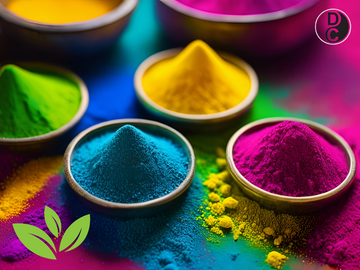Why Choose Eco-Friendly Colors for Holi?
Feb 12, 2025
Why Choose Eco-Friendly Colors for Holi?
The Holi Festival of Colors is an annual event eagerly anticipated by the people of India. Traditionally, the colors of Holi were originally derived from nature and had many symbolic meanings. The golden hue of turmeric (Haldi) represents purity and good fortune; the red-orange of the Palash flower symbolizes vitality.
However, with industrial development, chemical color powders have gradually replaced natural colors due to their lower cost. This has led to health and environmental concerns. Many people have called for the return of “green” Holi by using organic, nature-friendly colors. Beyond the environmental benefits, organic Holi colors also prioritize your health.
Natural Ingredients
Organic Holi colors are made from natural ingredients such as herbs, vegetables, flowers, and fruits. Red from Shalgam (beetroot), pomegranate peel, or roses; green from spinach or neem leaves; orange from Palash flowers; yellow from turmeric and besan (gram flour); purple from Chukandar (beetroot), blueberries, or Jacaranda flowers.
Safety
Free from harmful chemicals, eco-friendly Holi colors are gentle on the skin. Since they are made from natural ingredients, they are less likely to cause irritation or allergic reactions, making them safe for both children and those with sensitive skin.
Organic Holi colors are also safe for the eyes as they do not contain toxic chemicals, reducing the risk of eye damage.
Protecting Your Hair
Chemical dyes often contain harmful substances like synthetic colorants, heavy metals, and petroleum-based ingredients, which can strip moisture from the hair and irritate the scalp (not to mention the potential for long-term damage).
Meanwhile, organic Holi colors are made from natural ingredients like flowers, herbs, and plant extracts, which are gentler on the hair and scalp. They help reduce the risk of dryness, irritation, and hair breakage.
Biodegradable
Organic Holi colors are made from natural, plant-based ingredients. These materials decompose without leaving any harmful residue, making them a sustainable choice for celebrating Holi.
Pleasant Fragrances
Natural ingredients are mostly known for their pleasant, delightful scents. Sandalwood has a calming, woody fragrance. Orange peels release a fresh scent. Or rose petals exude a delicate aroma.
Why You Shouldn’t Use Synthetic Colors
Many of the colors used in Holi are made from hazardous chemicals like mercury and lead. Cheap colors are filled with synthetic dyes made from coal tar or petroleum. These abrasive and toxic substances can irritate your skin and eyes and pose potential health risks.
In addition, synthetic Holi colors take years to break down, leaving a lasting environmental impact.
Conclusion
The commercialization of Holi has resulted in festivals filled with cheap and toxic synthetic dyes. So, be wiser when choosing your Holi color supplier - opt for safe, organic products.
In addition to using eco-friendly colors, reduce water waste by selecting a dry Holi with natural powder, especially since many regions face water shortages. Use biodegradable items and opt for organic food. After the festivals, clean up the leftover colors to keep your neighborhood tidy.
Enjoy your festival with environmental awareness. Celebrate a green Holi that is eco-friendly, safe, and free from harmful chemicals.







